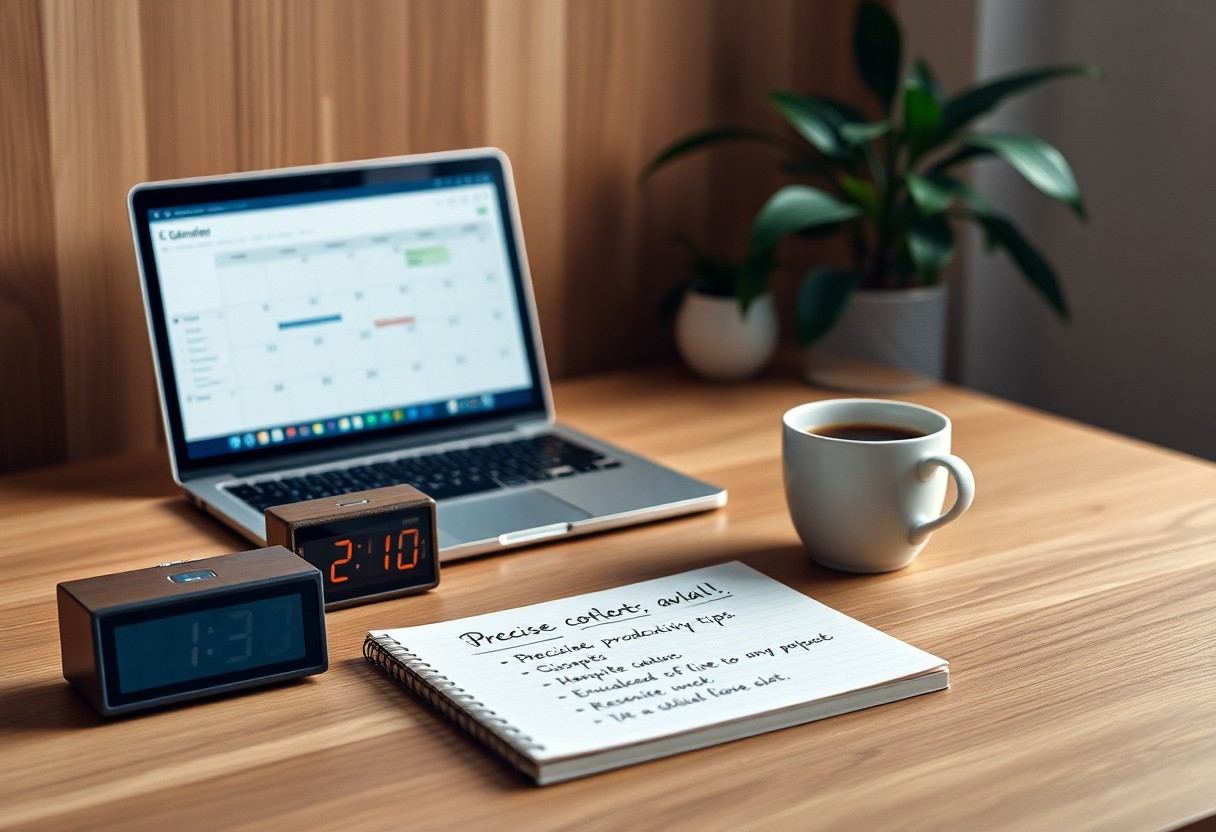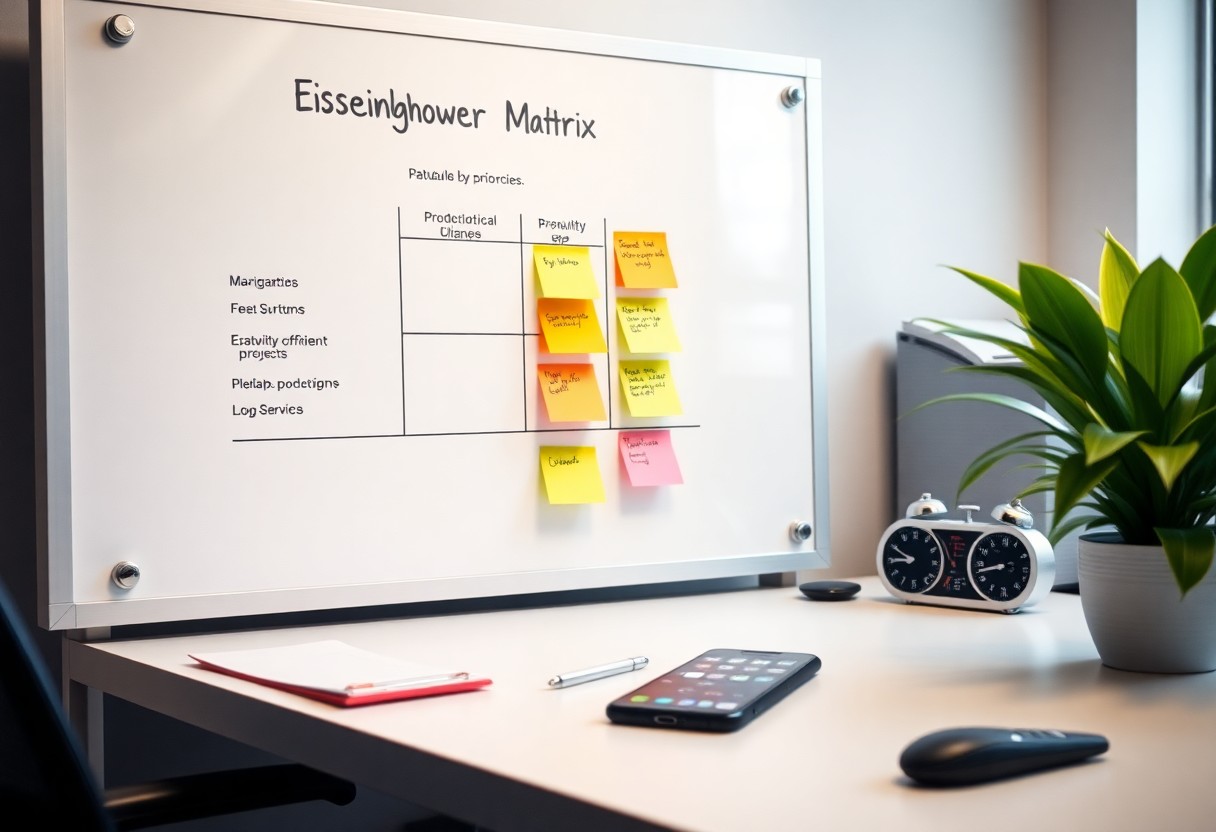It’s important to master your time management skills if you want to significantly enhance your daily productivity. By implementing specific strategies, you can maximize your efficiency and minimize distractions, allowing you to achieve more in less time. Learning to prioritize tasks and set actionable goals can lead to remarkable improvements in your workflow. Adopting these time control tips will help you take command of your day and unlock your full potential.

Key Takeaways:
- Prioritize tasks by importance and urgency to focus on what truly matters.
- Break larger tasks into smaller, manageable steps to maintain momentum.
- Set specific time limits for each task to encourage focused work sessions.
- Implement techniques like the Pomodoro Technique to balance work and breaks.
- Avoid multitasking to enhance concentration and efficiency in completing tasks.
- Utilize digital tools and apps for scheduling and reminders to stay organized.
- Review and adjust daily goals to ensure alignment with overall objectives.
The Psychology of Time Perception
Your perception of time significantly impacts how you approach tasks and manage your day. Factors such as emotional state, attention, and the novelty of experiences can warp your sense of time, making it feel like it flies by or stretches uncomfortably. Understanding these psychological nuances allows you to leverage time perception to enhance focus and structure your day more effectively, leading to increased productivity and a smoother workflow.
How Time Perception Influences Productivity
A warped sense of time can lead to ineffective scheduling and priorities. If you believe that a task will take longer than it actually does, you may procrastinate or avoid starting it altogether. Conversely, underestimating time can result in a rushed schedule, making it challenging to maintain quality in your work. By adjusting your perception and gaining awareness of time’s passing, you foster a more productive environment and efficiently complete tasks.
Cognitive Biases That Waste Time
Cognitive biases, such as the planning fallacy and optimism bias, often distort your assessment of how long tasks will take. These biases lead you to underestimate effort and time required, resulting in missed deadlines and frustration. Similarly, confirmation bias can trap you in unproductive routines, as you cling to familiar but ineffective behaviors while ignoring more effective alternatives.
The planning fallacy manifests when you consistently underestimate how long it will take to complete a task, causing you to overcommit and ultimately fall short. For example, if you anticipate needing just three days for a project that actually takes a week, you create a bottleneck that disrupts your schedule. Similarly, optimism bias leads you to focus on positive outcomes and ignore potential pitfalls. This combined effect can create significant inefficiencies in your daily workflow, making it vital to actively reconsider the time you allocate to tasks and remain open to adjusting approaches based on past experiences and more realistic assessments.

Strategic Prioritization: The Eisenhower Matrix
The Eisenhower Matrix helps you categorize tasks into four quadrants: urgent and important, important but not urgent, urgent but not important, and neither urgent nor important. Utilizing this framework enables you to focus on what truly moves the needle in your daily productivity. By assessing tasks in these categories, you can effectively allocate your time and energy to areas that require immediate attention and those that contribute to long-term goals.
Distinguishing Urgent vs. Important Tasks
Urgent tasks demand immediate action, often driven by external pressures, while important tasks align with your long-term objectives and values. By repeatedly assessing your to-do list, you can identify the distinctions between the two. For instance, responding to a last-minute meeting invitation might feel urgent, but developing a strategic plan for the upcoming quarter is what truly matters for your career advancement.
Creating Actionable Plans from Prioritization
After categorizing your tasks using the Eisenhower Matrix, the next step involves transforming your priorities into action plans. Break down the important tasks into smaller, actionable steps, assign deadlines, and create a schedule that reflects your prioritized list. This structured approach allows you to make tangible progress and reduces overwhelm, ensuring that you remain on track toward achieving your goals.
Establishing actionable plans requires specificity and clarity about each step involved in your important tasks. For example, if your goal is to complete a project, outline the specific phases—research, drafting, and revision. Assign deadlines for each phase, and schedule time blocks in your calendar dedicated solely to these tasks. This method not only clarifies your intentions but also prompts you to take consistent action, preventing procrastination and fostering a sense of accomplishment as you complete each segment.
Harnessing Technology for Time Efficiency
Utilizing technology effectively can significantly boost your daily productivity by streamlining processes and minimizing wasted time. Leveraging digital tools allows you to automate tasks, manage projects, and communicate more efficiently, which ultimately frees up time for more important work. Embracing the right technology enables you to focus on high-value activities rather than getting bogged down with repetitive tasks.
Essential Productivity Tools and Apps
Selecting the right productivity tools can transform your daily routine. Applications like Trello and Asana help you organize projects efficiently, while Evernote serves as a brilliant note-taking solution that keeps ideas at your fingertips. Integrating tools like Slack ensures seamless communication with your team, allowing you to collaborate without the clutter of endless email threads.
Automating Routine Tasks
Automating routine tasks enables you to save time and reduce the risk of human error. By using automation software like Zapier or Ifttt, repetitive processes become effortless. For instance, you can automatically save email attachments to your cloud storage or schedule recurring social media posts without manual intervention.
Consider automation for tasks like data entry and email follow-ups, where even simple scripts can dramatically cut down on hours spent. Implementing tools that can automatically categorize and label your incoming emails ensures your inbox stays organized, allowing immediate access to critical communications. You can save up to 20 hours a month by automating just a few daily tasks. This time can be reinvested into more strategic projects, boosting overall output while maintaining sanity and focus.
The Pomodoro Technique: Maximizing Focus
The Pomodoro Technique transforms productivity by breaking work into focused intervals, followed by short breaks. Each ‘Pomodoro’ lasts 25 minutes, allowing you to maintain intense concentration without burnout. This method creates a sense of urgency, helping you beat procrastination. You’ll find that by the end of your sessions, not only is the work produced of higher quality, but you also manage to reduce distractions and stay engaged with your tasks.
Setting Up an Effective Pomodoro System
To set up an efficient Pomodoro system, start with a simple timer—digital or analog works. Identify your tasks and write them down, estimating how many Pomodoros you need for each. Devote 25 minutes of undistracted work, turning off notifications and creating a dedicated space. After completing each Pomodoro, mark your progress, which reinforces motivation and keeps you aligned with your goals.
Adjusting Breaks for Optimal Performance
Breaks play a vital role in maintaining high productivity levels. After each Pomodoro, take a 5-minute break to recharge. This time can be spent stretching, grabbing a drink, or simply stepping away from your screen. After four Pomodoros, extend your break to 15-30 minutes to allow your brain to reset. Tailoring your breaks based on how you feel and your productivity at that moment enhances sustained focus and performance.
Fine-tuning your breaks can elevate performance significantly. If you encounter mental fatigue or feel distracted during a session, adjusting the length of your breaks can rejuvenate your focus. You might find that adding a light physical activity during breaks, such as a short walk or quick exercises, boosts energy levels further. Tracking your productivity against various break durations will help you discover what maximizes your concentration and efficiency, ensuring your Pomodoro sessions remain effective.

Building Sustainable Routines that Stick
Developing routines that you can maintain over the long term is important for consistent productivity. Focus on habits that align with your goals and values, incorporating them seamlessly into your daily life. Commit to incremental changes rather than overwhelming yourself with major shifts. Establishing a consistent wake-up time, setting specific work hours, and dedicating personal time for rest and hobbies create a foundation for high performance. These small yet powerful shifts can improve your focus and energy levels, making it easier to sustain productivity day-in and day-out.
Identifying Key Daily Habits for Productivity
To unlock your potential, identify habits that directly influence your productivity. Begin by assessing your current routine and pinpointing activities that either drive success or hinder progress. Focus on habits like prioritizing your tasks, maintaining a clutter-free workspace, and setting aside specific times for deep work. You might also explore techniques like time blocking or batching similar tasks to streamline efforts. By emphasizing key daily habits tailored to your personal preferences, you create a structure that propels you toward your goals.
Evaluating and Adjusting Your Routine Over Time
Your routine isn’t static; it must evolve based on your changing needs and experiences. Conduct regular assessments to identify what’s working and what isn’t. Use metrics like productivity levels, task completion rates, and overall satisfaction to gauge effectiveness. If you find certain habits aren’t producing desired results, be prepared to adjust or replace them with alternatives that better suit your current focus. This agile approach allows you to maintain momentum while ensuring your routine remains relevant and effective.
As you evaluate and adjust your routine, look for patterns in your productivity. Are there certain times of day when you feel more energized and focused? Leverage this insight to align your most challenging tasks with your peak performance windows. Seek feedback from trusted peers or mentors who can offer an outside perspective on your habits. Experiment with different approaches—perhaps incorporate a mid-afternoon break or shift your work environment. Adapting your routine based on real data and personal reflection facilitates sustained productivity and keeps you in control of your daily achievements.
Summing up
Following this guide on time control tips can significantly enhance your daily productivity. By prioritizing tasks, setting specific time blocks, minimizing distractions, and utilizing tools like calendars and timers, you can streamline your workflow. Emphasizing breaks to recharge can further improve focus and efficiency. Implement these strategies consistently to see a marked increase in what you can accomplish each day, ultimately leading to a more organized and productive life.
FAQ
Q: What are time control tips to manage distractions?
A: Identify common distractions and create a dedicated workspace. Use tools like website blockers and set specific times for checking emails or messages to minimize interruptions.
Q: How can setting specific goals improve productivity?
A: Establishing clear and achievable goals helps to maintain focus and motivation. Break large tasks into smaller milestones to track progress, making it easier to stay on task.
Q: What is the Pomodoro Technique and how does it enhance productivity?
A: The Pomodoro Technique involves working in focused bursts of 25 minutes followed by a 5-minute break. This method helps prevent burnout and maintains high concentration levels throughout the day.
Q: How does prioritizing tasks affect daily productivity?
A: Prioritizing tasks using methods like the Eisenhower Matrix allows individuals to focus on what is most important, ensuring that time is spent on high-impact activities rather than less critical ones.
Q: What role does time blocking play in effective time management?
A: Time blocking involves scheduling specific blocks of time for different tasks or activities. This structure helps limit distractions and creates a more organized approach to completing tasks.
Q: How can taking regular breaks improve overall efficiency?
A: Taking regular breaks helps recharge mental energy, enhancing focus and reducing fatigue. Short breaks throughout the day can increase overall work output and creativity.
Q: What techniques can be used for effective delegation to increase productivity?
A: Identify tasks that can be assigned to others based on their strengths and skills. Communicate clearly and set expectations, allowing for better use of time on tasks that require personal attention.
